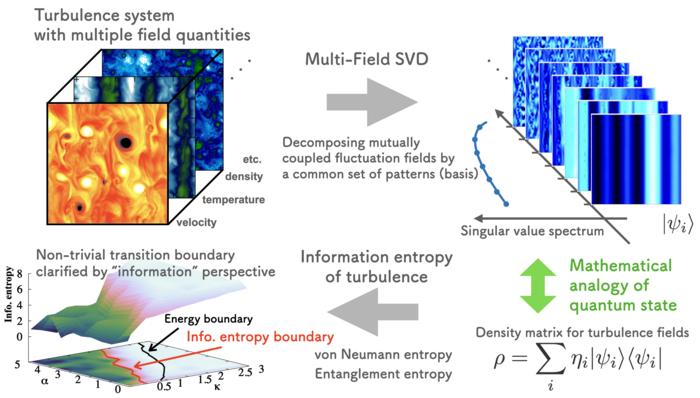In the vast and intricate realm of plasma physics, turbulence emerges as a formidable challenge, weaving complexity through the very fabric of fusion research. A recent breakthrough by scientists at the National Institute for Fusion Science and their collaborators has illuminated previously hidden dynamics within turbulent plasmas, employing innovative techniques inspired by quantum information theory. This pioneering work transcends traditional approaches, shedding new light on the elusive transitions in plasma turbulence with profound implications for the future of energy and beyond.
Turbulence is a ubiquitous phenomenon, manifesting in systems as diverse as ocean currents, atmospheric weather, interstellar gas clouds, human cardiovascular flows, and the plasmas central to fusion reactors. At its essence, turbulence represents a web of fluctuating vortices and flows whose interactions span spatial scales and evolve over time. Yet, the turbulence encountered in fusion plasmas defies simplistic characterization. Unlike ordinary fluid turbulence, plasma turbulence involves simultaneous fluctuations in multiple interconnected physical fields—density, temperature, magnetic and electric fields—each influencing the other in complex, interdependent ways.
Historically, plasma turbulence has been dissected through methodologies that treat fluctuations in individual fields somewhat independently, often decomposing turbulent behavior into waves propagating spatially with uniform characteristics. While useful, this wave-centric perspective struggles to capture localized, nonlinear vortex structures and the intertwined evolution of multiple fluctuating fields. These limitations have long constrained the scientific community’s capacity to fully understand—and eventually control—the turbulent processes that regulate energy confinement in fusion devices.
Addressing this conceptual impasse, researchers Go Yatomi and Motoki Nakata have devised a revolutionary analytical framework named multi-field singular value decomposition (MFSVD). This method generalizes the classical singular value decomposition technique to accommodate multiple simultaneous datasets representing different physical fields, extracting common spatial patterns where fluctuations in density, temperature, electric potential, and other quantities are coherently coupled. Such decomposition unveils a multi-dimensional portrait of plasma turbulence, revealing how complex, interwoven structures emerge and evolve collectively rather than in isolation.
What sets MFSVD apart is not only its capacity to unify multi-field data but also its seamless integration with concepts from quantum information theory. Building upon the decomposition’s output, the researchers introduced two entropy-based metrics: the von Neumann entropy (vNE) and the entanglement entropy (EE). These information-theoretic quantities quantify, respectively, the complexity and diversity of turbulent fluctuations, and the degree to which different turbulent structures interrelate and influence one another. Interestingly, both metrics derive from a density matrix that parallels the mathematical constructs used to describe quantum states, forging an elegant analogy between turbulent classical systems and quantum mechanical phenomena.
The implications of applying vNE and EE to plasma turbulence are profound. Using advanced numerical simulations of plasma models, the research team uncovered a subtle transition in the turbulent state—one invisible to conventional energy-based analyses. This transition represents a sudden reorganization in the collective vortex patterns within the plasma, suggesting previously unrecognized structural shifts that could critically affect macroscopic flow behavior and the confinement properties essential for fusion performance. By highlighting hidden changes in turbulence morphology, vNE provides a sensitive detector for evolving plasma states, opening new diagnostic avenues.
Even more striking is the capability of entanglement entropy to encapsulate detailed nonlinear interactions within the turbulent plasma. Traditionally, analyzing energy transfer and interaction among turbulent structures requires processing vast datasets with complex correlation analyses. EE condenses this information into a single comprehensive measure that reflects when, where, and how different turbulent modes exchange energy or fluctuations. Such insight is vital for deciphering the mechanisms by which turbulence self-organizes, potentially enabling targeted control interventions in fusion devices.
Beyond plasma physics, the methodological innovations introduced hold wide-reaching potential. Systems characterized by multiple interacting fields and scale-dependent fluctuations abound in nature and society. The information entropy framework devised here offers a versatile lens to examine turbulence analogs in atmospheric sciences, oceans, traffic flows, and even social dynamics. Its ability to gauge when measurements suffice and to prioritize which structures warrant observation makes it invaluable in experimental scenarios constrained by limited sensor capabilities.
Looking forward, the research team intends to deepen the theoretical linkages between information entropy in turbulence and principles from quantum information science. This interdisciplinary dialogue promises not merely incremental improvements but a paradigm shift in how complex nonlinear systems are understood and managed. Moreover, advancing the application of these analytical tools to real-world experimental data could soon transform monitoring and control strategies in fusion research and beyond.
This fusion of quantum-inspired mathematical frameworks with classical turbulence analysis epitomizes a modern scientific synthesis, where cross-disciplinary insights illuminate long-standing mysteries. By quantifying the complexity and interconnectedness of plasma turbulence through entropic measures, this study charts a path toward mastering one of the most obstinate barriers to practical fusion energy. The consequences are profound, supporting the development of cleaner, inexhaustible power sources and contributing to our broader comprehension of complex dynamical systems.
As fusion reactors edge closer to viability, understanding and controlling turbulence remains paramount. Innovations such as MFSVD and the application of quantum-inspired entropy metrics not only enhance analytical resolution but also empower researchers to recognize subtle transitions and interactions previously masked within turbulent chaos. This capacity to decode complexity in an efficient, mathematically robust manner heralds a new era of turbulence research poised to influence multiple scientific domains.
In conclusion, the pioneering work of Yatomi, Nakata, and colleagues represents a significant leap in turbulence analysis, seamlessly marrying computational physics, plasma science, and quantum information theory. Their approach transcends conventional paradigms and offers a powerful toolkit for exploring the intricate dance of vortices and flows within turbulent plasmas. With continued theoretical refinement and experimental application, this quantum-inspired information entropy framework may not only unravel plasma turbulence mysteries but also illuminate complex phenomena across the physical and social sciences.
Subject of Research: Not applicable
Article Title: Quantum-inspired information entropy in multifield turbulence
News Publication Date: 2-Jun-2025
Web References: http://dx.doi.org/10.1103/PhysRevResearch.7.023212
References: Physical Review Research, DOI: 10.1103/PhysRevResearch.7.023212
Image Credits: National Institute for Fusion Science
Keywords: plasma turbulence, multi-field singular value decomposition, information entropy, von Neumann entropy, entanglement entropy, fusion energy, quantum information theory, turbulent transitions, computational modeling




